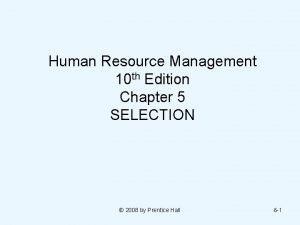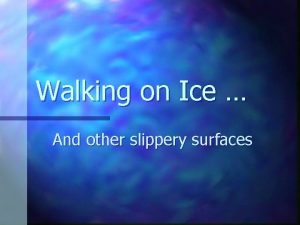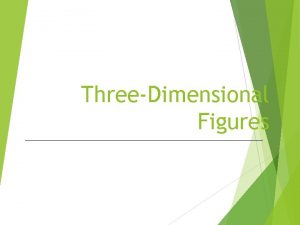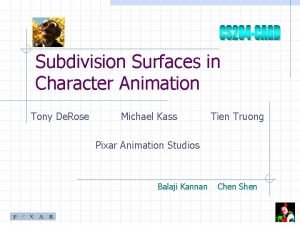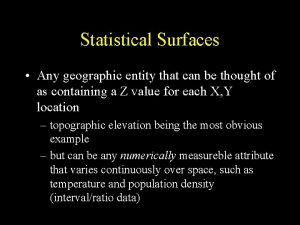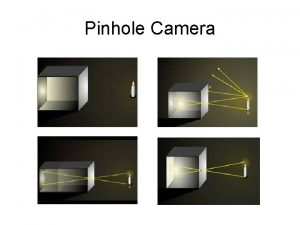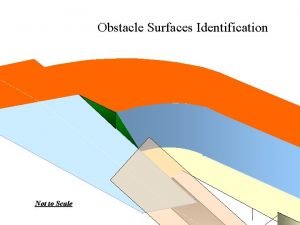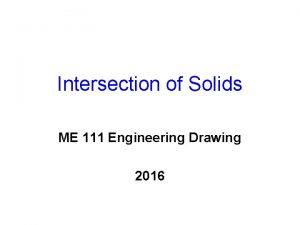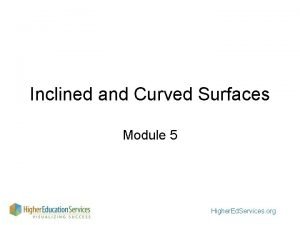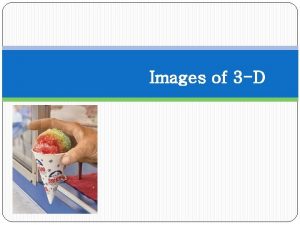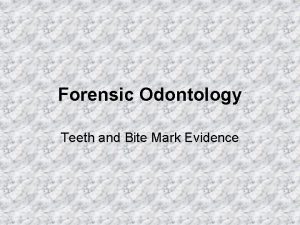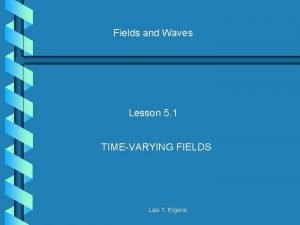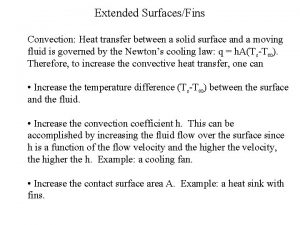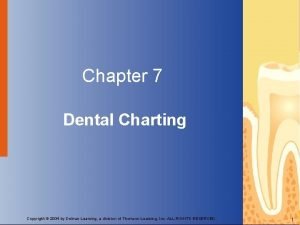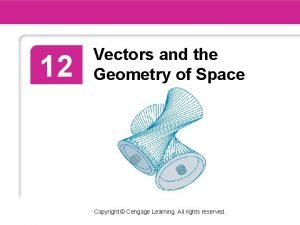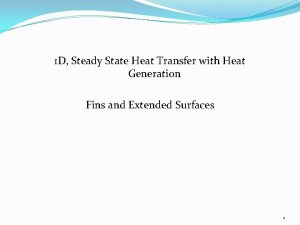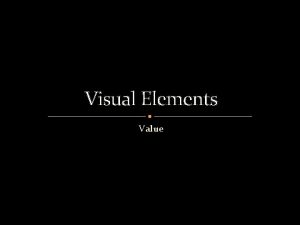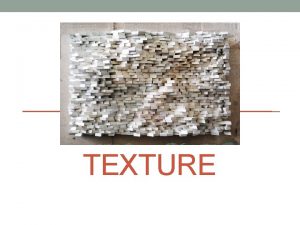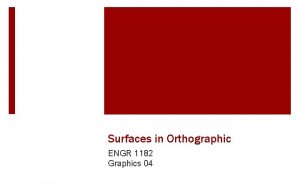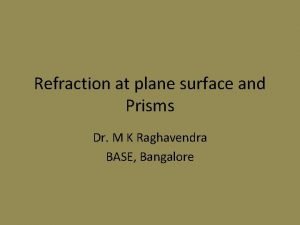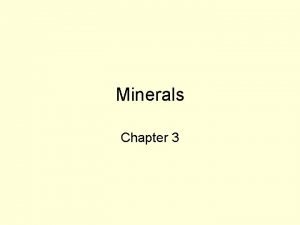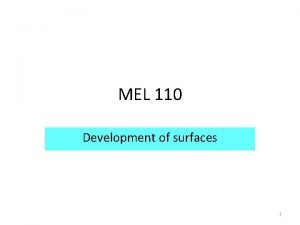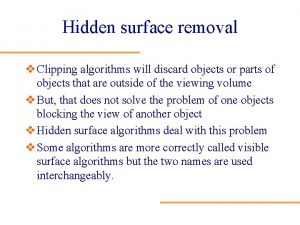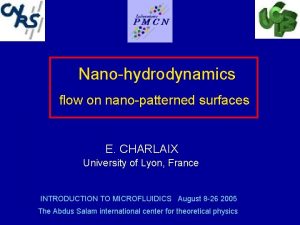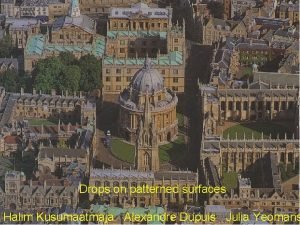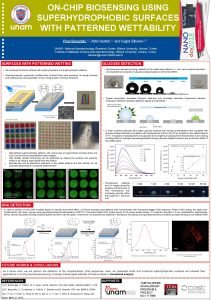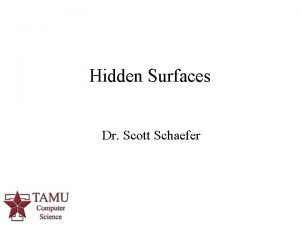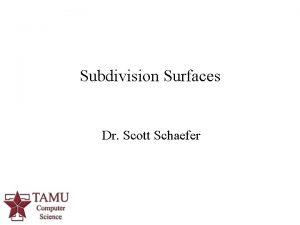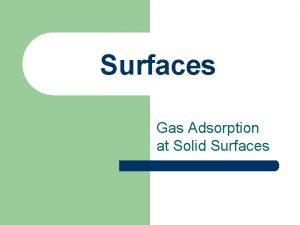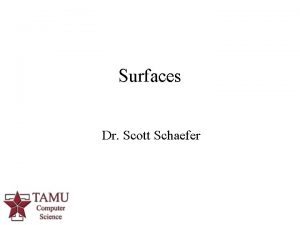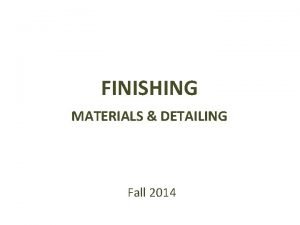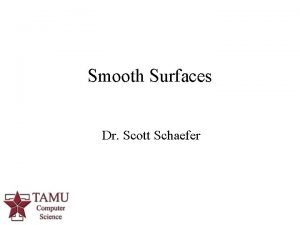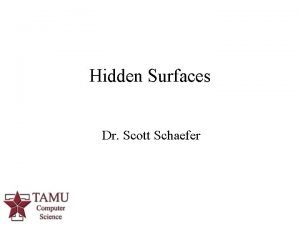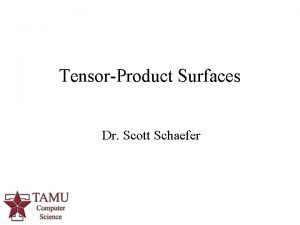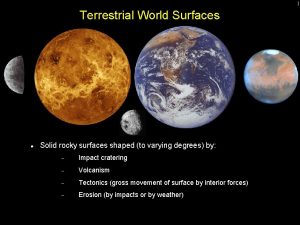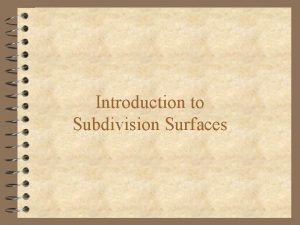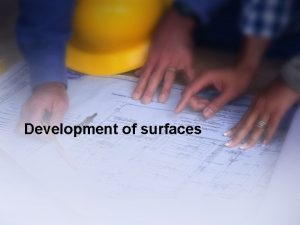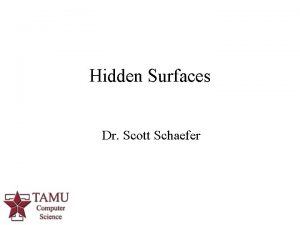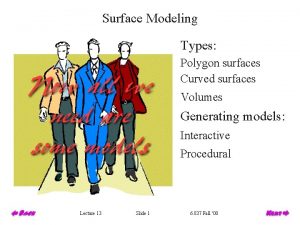Flow on patterned surfaces E CHARLAIX University of









































- Slides: 41

Flow on patterned surfaces E. CHARLAIX University of Lyon, France NANOFLUIDICS SUMMER SCHOOL August 20 -24 2007 THE ABDUS SALAM INTERNATIONAL CENTER FOR THEORETICAL PHYSICS

OUTLINE 1. The bubble mattress ü Basics of wetting / Superhydrophobic surfaces ü Cassie/Wenzel transition on nanoscale patterns 2. Surfing on an air cushion ? ü The flat heterogeneous surface: hydrodynamics predictions ü Nanoscale patterned surfaces: MD simulations ü Nanorheology experiments on carved SH surfaces ü CNT’s and the wetted air effect

Roughness and wetting : a conspiracy ? Hydrodynamic calculations : roughness decreases slip. On non-wetting surfaces, can roughness increase slip ?

n Watanabee et al J. F. M. 1999 Rough surface with water-repellent coating Contact angle 150° Very large slip effects (200 µm) Drag reduction in high Re flows 100µm 20µm

Super-hydrophobic surfaces: surfing on an air-cushion ? Lotus effect Bico, Marzolin & Quéré Europhys. Lett 47, 220 (1999)

BASICS OF WETTING g. SL : solid-liquid surface tension g. SV : solid-liquid surface tension g. LV partially wetting liquid : < 90° g. SV g. SL non wetting liquid : > 90° equilibrium contact angle : Young Dupré relation g. SV - g. SL = g. LV cos perfect wetting liquid : =0°

WETTING OF A ROUGH SURFACE Young’s law on rough surface: Wenzel law o : contact angle on flat chemically same surface 1 -1

2 a WETTING OF A PATTERNED SURFACE h Bico, Marzolin & Quéré Europhys. Lett 47, 220 (1999) Trapped air is favorable if -1 composite wetting Wenzel law Liquid must be non-wetting -1

2 a CASSIE-WENZEL TRANSITION h Young’s law for Cassie wetting: Bico, Marzolin & Quéré Europhys. Lett 47, 220 (1999) -1 Cassie wetting Cassie-Baxter’s law Wenzel wetting -1

METASTABILITY OF WETTING ON MICROPATTERNED SURFACES Lafuma & Quéré 2003 Nature Mat. 2, 457 Cassie state Compression of a water drop between two identical microtextured hydrophobic surfaces. The contact angle is measured as a function of the imposed pressure. Wenzel state

Lafuma & Quéré 2003 Nature Mat. 2, 457 Contact angle after separating the plates Cassie state Wenzel state Maximum pressure applied

METASTABILITY OF CASSIE/WENZEL STATES ∆P prepared in Cassie state d Transition to Wenzel state at -1 Robust Cassie state requires small scale and deep holes -1

Non-wetting nano-textured surfaces : MD simulations Cottin-Bizonne & al 2003 Nature Mat 2, 237 1 µm

Lennard-Jones fluid = {liquid, solid}, e : energy scale : molecular diameter c b : wetting control parameter Non-wetting situation : c. Ls = 0, 5 : o =140° N : nb of molecule in the cell

Wetting state as a function of applied pressure Pressure (u. L. J. ) C b = 0. 5 = 140° N is constant Volume Imbibated (Wenzel) state Super-hydrophobic (Cassie) state

Cassie-Wenzel transition under applied pressure Cassie state Wenzel state Gibbs energy at applied pressure P Super-hydrophobic state is stable if Super-hydrophobic transition at zero pressure For a given material and texture shape, super-hydrophobic state is favored if scale is small

Pressure (u. L. J. ) Wetting state as a function of applied pressure Volume Wenzel state Cassie state

Flow on surface with non-uniform local bc y x Local slip length : b(x, y) (Independant of shear rate) b=∞ : (favorable) approximation for gaz surface What is the apparent bc far from the surface ?

Effective slip on a patterned surface: macroscopic calculation Couette flow L Local slip length : b(x, y) Bulk flow : Stokes equations Apparent slip: Shear applied at z = Decay of flow corrugations

Stripes of perfect slip and no-slip h. b. c. Effective slip length flow · Stripes parallel to shear (Philip 1972) analytical calculation Bad news ! The length scale for slip is the texture scale Even with parallel stripes of perfect slip, effective slip is weak: B// = L for z = 0. 98

flow · Stripes perpendicular to the shear (Stone and Lauga 2003) · 2 D pattern: semi-analytical calculation (Barentin et al EPJE 2004)

AN EXPERIMENTAL REALISATION Hydrophobic silicon microposts 127 µm Pressure drop reduction Ou, Perot & Rothstein Phys Fluids 16, 4635 (2004) 21 µm Slip length Good agreement with MFD… … why not just remove the posts ?

Flow on nano-textured SH surfaces : MD simulation

Flow on nano-textured surface : Wenzel state - on the smooth surface : slip = 22 - on the imbibated rough surface : slip = 2 Roughness decreases slip

Flow on the nano-textured surface : Cassie state - on the smooth surface : slip = 24 Roughness increases slip - on the super-hydrophobic surface : slip = 57

Influence of pressure on the boundary slip d Pcap = -2 glv cos d Slip length (u. L. J. ) Barentin et al EPJ E 2005 150 Superhydrophobic state 100 50 Imbibated state 0 0 1 P/Pcap 2 3 The boundary condition depends highly on pressure. Low friction flow is obtained under a critical pressure, which is the pressure for Cassie-Wenzel transition

Comparison of MD slip length with a macroscopic calculation on a flat surface with a periodic pattern of h. b. c. More dissipation than macroscopic calculation because of the meniscus

Flow on patterned surface : experiment square lattice of holes in silicon obtained by photolithography fraction area of holes: 1 -F = 68 ± 6 % L = 1. 4 µm holes Ø : 1. 2 µm ± 5% bare silicon hydrophilic OTS-coated silicon superhydrophobic L = 1. 4 µm B =50 +/-20 nm Wenzel wetting Calculation of BC: effective slip plane B =170 +/-30 nm Cassie wetting Qa=148° Qr =139°

Nanorheology on patterned surface: SFA experiments Hydrophobic (silanized) Cassie Hydrophilic Wenzel 1/G"(w) Bapp = 100 +/- 30 nm 0 D(nm) 1200 Bapp = 20 +/- 30 nm

Elastic response on Super. Hydrophobic surfaces Elasticity G’(w) SH surface Hydrophilic surface Force response on SH surface shows non-zero elastic response. Signature of trapped bubbles in holes.

Flow on a compressible surface Newtonian incompressible fluid Lubrication approximation Local surface compliance viscous damping K : stiffness per unit surface [N/m 3] d elastic response

Flow on a compressible surface no-slip on sphere partial slip on plane d Non-contact measurement of surface elasticity K

Surface stiffness of a bubble carpet L=1, 4 µm a=0, 65 µm a Experimental value meniscus gaz L

Effective slippage on the bubble carpet (FEMLAB calculation) slip plane no bubble hydrophilic no bubbles SH surfaces can promote high friction flow slip plane

Take-home message q Low friction flow at L/S interface (large slippage) is difficult to obtain q Tailoring of surfaces is crucial !!! Eg: for pattern L=1µm, want to obtain b=10µm requires Fs = 0. 1% (solid/liquid area) corresponds to c. a. ~ 178° (using Cassie relation) meniscii should be (nearly) flat

Some hope…. flow on a « dotted » surface: hydrodynamic model No analytical results L a Posts a<<L argument of L. Bocquet

Flow on a « dotted » surface: hydrodynamic model L a Posts a<<L ØThe flow is perturbed over the dots only, in a region of order of their size Ø Friction occurs only on the solid surface better than stripes Numerical resolution of Stoke’s equation: ~1/p

SLIPPAGE ON A NANOTUBE FOREST q Nanostructured surfaces C. Journet, J. M. Benoit, S. Purcell, LPMCN PECVD, growth under electric field 1 µm q Superhydrophobic (thiol functionnalization) = 163° (no hysteresis) C. Journet, Moulinet, Ybert, Purcell, Bocquet, Eur. Phys. Lett, 2005

thiol in gaz phase thiol in liquid phase before after Bundling due to capillary adhesion

L=1. 5 µm L=3. 2 µm L=6 µm Stiction is used to vary the pattern size of CNT’s forest

CNT forest is embeded in microchanel Pressure driven flow PIV measurement b (µm) Cassie state Slip length increases with the pattern period L 0. 28 Wenzel state
 Patterned response definition
Patterned response definition Patterned interview
Patterned interview Reservoir nasal cannula
Reservoir nasal cannula Venturi mask 50 percent
Venturi mask 50 percent O2 liters to fio2
O2 liters to fio2 Difference between laminar and turbulent flow
Difference between laminar and turbulent flow Internal versus external flow
Internal versus external flow Flow energy review
Flow energy review Oikos meaning
Oikos meaning Transform flow and transaction flow in software engineering
Transform flow and transaction flow in software engineering Data flow structure
Data flow structure Rotational vs irrotational flow
Rotational vs irrotational flow External flow vs internal flow
External flow vs internal flow Data flow vs control flow
Data flow vs control flow Cheese manufacturing process flow chart
Cheese manufacturing process flow chart Control flow and data flow computers
Control flow and data flow computers Control flow vs transaction flow
Control flow vs transaction flow Walking on slippery surfaces
Walking on slippery surfaces How many faces square pyramid have
How many faces square pyramid have Subdivision surfaces in character animation
Subdivision surfaces in character animation To determine missing z values for a statistical surface
To determine missing z values for a statistical surface Reflection
Reflection Vestibule heart
Vestibule heart Obstacle identification surface icao
Obstacle identification surface icao Intersection in technical drawing
Intersection in technical drawing Orthographic projection of curved surfaces
Orthographic projection of curved surfaces What shape has 4 vertices
What shape has 4 vertices Famous bite mark cases
Famous bite mark cases Imaginary surfaces
Imaginary surfaces Advection vs convection
Advection vs convection I have 8 vertices
I have 8 vertices Lingual pit
Lingual pit Quadric surfaces chart
Quadric surfaces chart Heat transfer from extended surfaces fins
Heat transfer from extended surfaces fins The relative lightness and darkness of surfaces.
The relative lightness and darkness of surfaces. Refers to the surface quality
Refers to the surface quality Whats missing
Whats missing Magic wall interactive surfaces market segments
Magic wall interactive surfaces market segments Refraction at plane surfaces
Refraction at plane surfaces The splitting of a mineral along smooth flat surfaces
The splitting of a mineral along smooth flat surfaces What is development of surfaces
What is development of surfaces Clipping algorithms are used to remove hidden surfaces.
Clipping algorithms are used to remove hidden surfaces.

